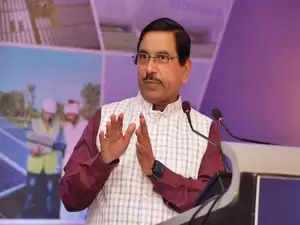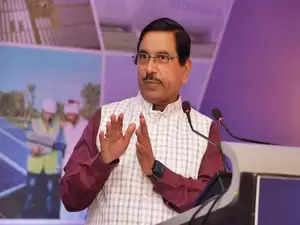

Mumbai, Feb 24 (IANS) India will need Rs 30 lakh crore (Rs 5 to 6 lakh crore annually) to achieve 500 GW of non fuel based energy (Renewable Energy) by 2030. This will be raised through multiple sources including public sector banks, financial institutions, international credit, equity funding, debt funding, corporate bonds and pension funds.
Union Minister for New and Renewable Energy Pralhad Joshi, who was accompanied by Minister of State Shripad Naik, said this here on Monday after attending a day-long national workshop on mobilising finance for RE.
"Availability of finance for RE projects has emerged as one of the key challenges across all RE technologies in the industry consultations. However, the Centre is quite pro-active in taking necessary policy decisions and providing financial incentives in addition to helping the industry players and developers to get an access to the required funds and technologies.
"The government has stepped up efforts to bring stronger participation of mainstream public sector unit lenders into the utility scale RE, develop credit enhancement mechanism to bring pension, insurance and corporate bond capital in a big way,” said the minister during his interaction with the media.
He further stated that the Ministry of Renewable Energy has been keeping a continuous monitoring and making efforts for reduction of project risks including delays in transmission projects and implementation of power purchase agreement and issues relating to land acquisition.
"There is a need to bring international lenders into the Indian market,” he added.
The minister said that the government is quite ambitious to achieve the 500 GW of RE by 2030 as India’s power demand is expected to double by 2032.
“India’s energy consumption is projected to grow rapidly. Investing in RE is essential to meet this demand sustainably and reduce reliance on fossil fuels. A strong push for localised manufacturing of solar modules, wind turbines, battery storage and electroalyzers is necessary to build a resilient clean energy ecosystem,” he added.
The minister said with a cumulative installed capacity of 100 GW as of January 31, 2025, solar power has become the central piece of India's RE strategy.
He added that investments are needed in large-scale solar parks, rooftop installations and solar manufacturing units to meet increasing energy demands.
According to the minister, India's wind power capacity reached 48.3 GW as of January 31, 2025.
“The government is promoting investment in onshore and offshore wind projects as well as turbine manufacturing,” he said.
In a bid to harness the intermittency of RE sources, investments in energy storage systems such as battery storage, pumped hydro storage, hydrogen storage and other emerging technologies are essential for grid stability and round-the-clock RE supply, he said.
“The central and state governments offer various incentives, including tax benefits and subsidies, to attract investments and accelerate RE adoption. Policies like the Production Linked Incentive scheme for solar manufacturing and the Green Hydrogen Open Access rules are already driving significant investments,” he added.
The minister said that the government is actively pursuing the implementation of the National Green Hydrogen Mission. It has an outlay of Rs 19,744 crore.
The minister said that under the flagship PM-KUSUM Yojana, the government proposes to provide electricity to farmers during the daytime.
PM-KUSUM seeks to deploy 10 GW of decentralised solar plants on farmer-owned lands, install 14 lakh standalone solar pumps, and solarise 35 lakh grid-connected agricultural pumps -- known as Components A, B, and C, respectively.
By subsidising solar pump adoption and supporting DISCOMs to solarise grid-connected pumps with decentralised solar plants, the scheme delivers reliable daytime power to farmers.
As far as PM Surya Ghar: Muft Bijli Yojana (PMSGMBY) is concerned, the minister said so far about 9.5 lakh households benefitted through rooftop installations.
The scheme provides households with free electricity through the installation of subsidised rooftop solar panels, significantly reducing their energy costs.
--IANS
sj/pgh